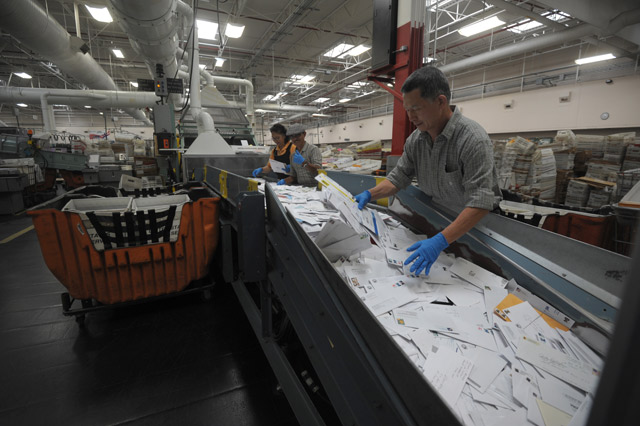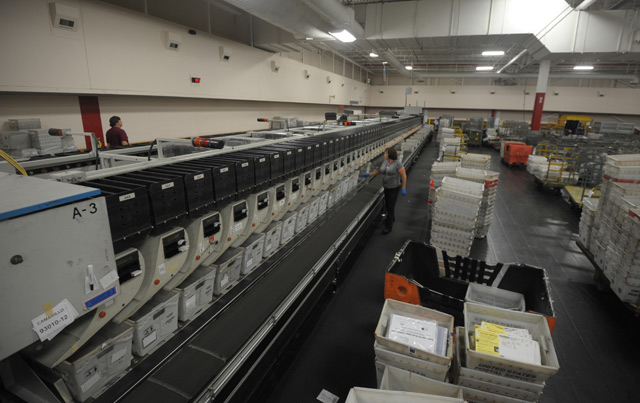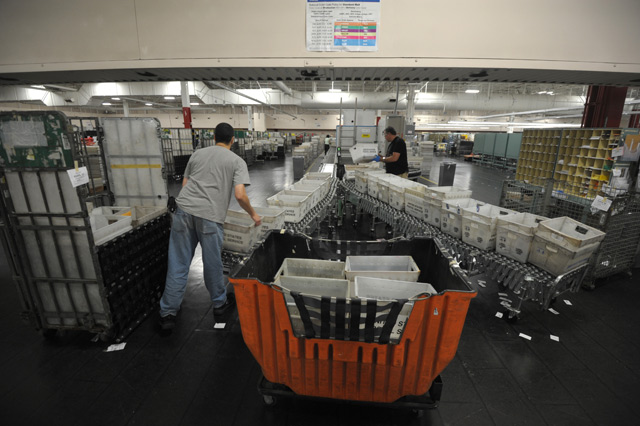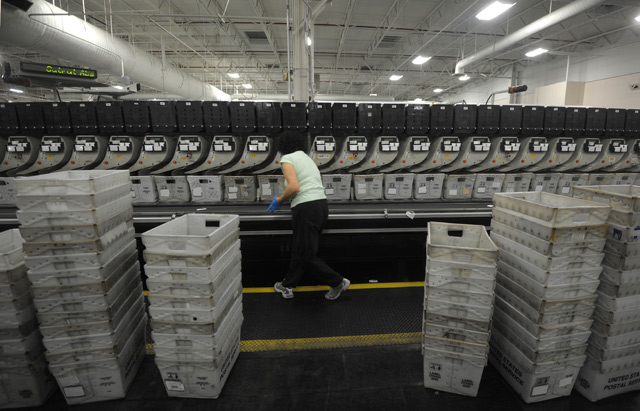The Busiest Building in Town
Bucking the National Trend of Post Office Shutdowns, Goleta Processing Center Grows

Early each and every morning, long before the hectic hurry of commuters shatters the stillness that modestly announces each new day, there is a building in Goleta that is a whirling, whizzing hive of organized and productive chaos. At this building, 240,000 square feet of machines and humans and overhead lights dance with a steady inflow and outflow of several dozen trucks, each of them, before they depart, stuffed to capacity with wedding invitations, birthday cards, magazines, credit-card bills, and assorted other types of mail headed to homes and places of business all over the world.

Of course, we are talking about the U.S. Postal Service’s Processing Center on Storke Road — a place that, even as the Postal Service faces down billions of dollars’ worth of budget trouble and related closures and job cuts all over the country, is busier than ever before. In fact, to hear the plant’s manager John Byars tell it, “We are exactly twice as busy as we ever have been. It’s really pretty insane right now.” It wasn’t long ago that the Goleta station, though certainly busy in its own way, was but a shadow of its current self with a thundercloud of uncertainty shrouding its horizon. The U.S. Postal Service has been in a flat-out free fall over the past five years thanks in large part to the advent of email, smart phones, text messaging, and assorted other technologically transformed modes of communication, and many feared that the nondescript and underutilized Goleta processing center would be closed in favor of its busier, more centrally located counterpart in Oxnard.

However, late last month, the aforementioned wave of post office closures officially rolled through Oxnard — to date, 3,700 offices have been closed nationwide, with still more to come in the months ahead, including a tentative plan to shutter the Victoria Court post office in downtown Santa Barbara — leaving Goleta as the sole South Coast processing plant, at least for now. Even better, Goleta ended up inheriting several sorting machines from Oxnard, mail handlers and mechanics to go along with them, and, above all else, a mighty, mighty uptick in mail volume. Now, thanks to the closure of the Oxnard facility, Goleta handles all the mail from Simi Valley to San Simeon and then some. “We went from an average of 650,000 to 800,000 pieces of letter mail a day to an average of right around 1,675,000 a day,” explained Byars recently with a tone of amazement. “Oh, and on the Tuesday after Labor Day, we did 2.2 million in letters alone,” he added, as if delivering the punch line of a joke.

Specifically, after the Oxnard closure last month, Goleta is now the main gathering place of all mail headed to zip codes that start with 930, 931, 932, 933, and 934 — a territory that essentially encompasses much of the tri-county area. To meet the demands of this new and expanded service zone, the facility — which is up and running 24 hours a day, 7 days a week — has had to grow into its previously oversized infrastructure shoes, a process that rolled out slowly and deliberately during the last three weeks of August with the addition of 15 new sorting machines (which, when maxed out, hum to the tune of roughly 35,000 letters per hour!), a new “flat” sorter, and increased staffing for most shifts, including more than 60 former Oxnard employees, as well as several new hires.

To make matters worse, the change came just as the annual “fall mailing season” began — a time of year where mail volumes begin to increase steadily up until the holidays. In fact, in the three weeks since the expansion concluded, Goleta has enjoyed only one “soft day.” That is to say, only once has its daily letter volume dipped below the one-million mark. Reflecting on the transition and what it has meant for the 300-plus regular employees under his charge, Byars — who has worked for the Postal Service in Santa Barbara since 1984 and has been plant manager at the Goleta station for the last four years — said, “You know, this is actually what we want to do. It is important to stay relevant and keep us on the map. It’s been crazy, and we still have a few tweaks and growing pains to get it perfect, but, overall, it went quite well.” As for why his plant survived and Oxnard didn’t during the latest round of closures, Byars opined, “Well, it wasn’t due to their performance, I know that much. They ran a great operation … I guess, once they evaluated everything, we had room to grow here, and we even have more if it ever gets to that point. I also think our transportation capacity was higher, and when you consider the driving routes and that the next closest [processing plant] is in Santa Clarita, our location was better from a cost perspective.”

Despite the changes in Goleta, the future is, as Byars would be the first to tell you, anything but certain for the U.S. Postal Service and its various outposts here in the 805. After all, by their reckoning, they have lost out on 43 billion pieces of mail since 2006 thanks to technological improvements in stamp-less communication — a number so large that it has the agency actively looking to make some $3 billion in annual cuts. To this end, in an open letter to the public last week that detailed what those savings may look like, Patrick Donahoe, the United States postmaster general, stated simply, “We are forced to face a new reality today … With the dramatic decline in mail volume and the resulting excess capacity, maintaining a vast national infrastructure is no longer realistic.”
With that in mind, everything from closing half of the processing plants in the country (for what it’s worth, the Goleta plant is not on this new list), drastically cutting the Postal Service’s fleet of shipping vehicles, laying off as many as 35,000 positions, and changing the service standards of First-Class mail are all being explored. “Currently, we are safe, but it is going to get tough,” concluded Byars late last week. “We just have to stay productive.”


